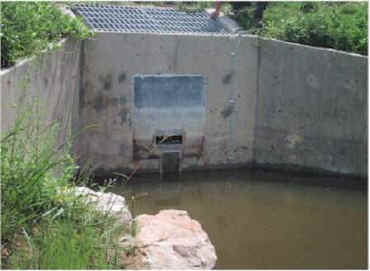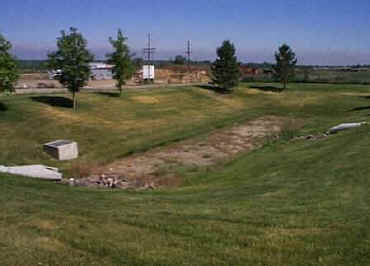|
|
Do BMPs Protect Our Receiving Waters?by
|
 |
| Figure 1. Extended detention outlet installed June 2001 in operation in August - 18 hours after storm’s end. Note the partially submerged well-screen type trash rack, the debris line that is near the bottom of the 10-year control orifice and the 100-year overflow on top. |
The Urban Drainage and Flood Control District (District) attempted, in its latest version of the USDCM, to address a significant number of design, nuisance, maintenance, and performance problems; and to better quantify the needed water quality capture volume and emptying times for different BMPs. It also includes new outlet design details for extended detention basins, retention ponds and wetland basins. Figure 1 shows an outlet with a micro-pool and a properly sized stainless steel well-screen type trash rack. The perforated riser plate that controls the emptying time is mounted behind the trash rack. This is from an installation at Grant Ranch that the District, in cooperation with the Grant Ranch Metropolitan District, retrofitted into an existing extended detention basin that originally had an older type perforated riser pipe outlet and no micro-pool.
The pre-retrofit basin was experiencing outlet clogging problems and its bottom became a soggy, unusable, nuisance to the neighborhood. The District will collect data on rainfall, flow rates and water quality at this installation over the next two to three years to see how well the recommended design performs. We observed that this design virtually eliminated clogging and sediment accumulation problems at the outlet. Two other extended detention basins nearby were observed last summer to not empty properly, while the retrofit basin had its water quality capture volume empty within the 40-hour design period of time.
 |
| Figure 2. Sand filter with water quality capture volume above it, installed late 1980s. Note two inlet pipes and an overflow for larger storms. Volumes below the overflow are filtered and, because site conditions permit, infiltrated into the ground. |
Another design that the District introduced in its USDCM is a sand filter basin, and an example is shown in Figure 2. It provides for a water quality capture volume above the filter’s surface and flood routing above the overflow outlet. We expect these filter basins will operate well, provide significant peak flow attenuation and require reasonable maintenance to stay in operation. AutoCAD™ details for these designs are available for download at the District’s web page www.udfcd.org.
The universal use of BMPs can be very expensive. Many BMPs require the dedicated use of expensive land areas, and their ongoing operation and maintenance have a significant price tag. If the selected BMPs provide a level of protection for the receiving waters, the price may be worth it. However, if they do not, then much money is being spent building facilities for naught. The only way to answer whether what we are installing and maintaining in our communities is effective is to have the Federal Government, states, and local jurisdictions commit to a long-term national program of basic research. The research being suggested would help quantify the linkages between urban stormwater BMPs and their ability to mitigate the impacts of urbanization on receiving waters.
To assist with these research needs, the Water Environment Research Foundation has launched a stormwater research program. It will fund this effort by seeking Federal and other grants and through subscriptions by municipalities (i.e., cities, counties, special districts, stormwater utilities, etc.). Subscribers will have access to advance information that will not be available to the public until research projects are fully completed. The authors encourage all municipalities to become subscribers. The research that will be needed is very expensive and no single entity will be able to afford it. By joining forces and funds, there is a chance that we will be seeing answers to some of the questions that still need to be answered.
There are sufficient data and observations in place today that show urbanization does change the nature, quality and quantity of surface runoff and groundwater flows reaching the nation’s receiving waters. These include changes in the rates, volumes, frequency, and quality of the surface runoff. All of these are attributed to the observed physical, chemical, and biological changes of the receiving water systems. There also have been several reported efforts to compile information on the effects of urbanization and impacts on receiving water. Many of these studies, although good to excellent in their own right, either did not follow consistent protocols or attempted to couple data from various sources to develop linkages between observed effects and impacts. Namely, reporting that the Rapid Bio-assessment Index showed degradation between upstream and downstream reaches of an urban area does not tie these degradations to specific effects of urbanization.
There were only a very few attempts to link the performance of stormwater BMPs with their ability to mitigate the observed impacts of urbanization (e.g., State of Maryland; King County, Washington; Austin, Texas). Although studies by Maxted (1999) and Maxted and Shaver (1997) looked at the ability of retention basins and Horner, et. al. (expected publication in late 2001) looked at extended detention basins to mitigate the impacts of urbanization on aquatic biota, none of those studies attempted to link specific BMP design parameters (i.e., various types, surface areas, and capture volumes relative to local mean runoff volume, release rates, etc.) to their effectiveness. None of them looked at entire systems of municipal BMPs that thoroughly cover the watershed and can operate simultaneously.
There is a clear need to establish an approach to develop a nationwide quantitative evaluation of BMPs and their ability to mitigate impacts. We need an effort that will attempt to link the performance of various types of BMPs and their design parameters such as type, size, volume, surface area, flow release rates, potential for infiltration, etc. To be credible a research effort that addresses and quantifies the linkages between BMPs and their ability, as part of a total municipal system, to mitigate impacts of urbanization on receiving water will need to:
This effort will need to be aimed at defining which physical (i.e., hydrologic, geomorphic, stream power, sedimentation, erosion, etc.), chemical (i.e., toxicity, oxygen availability, etc.) and biological (i.e., numbers and types of species of flora and fauna, habitat, eutrophication, etc.) processes are at work and what may be achievable through the use of individual BMPs and systems of BMPs in urban areas to mitigate the effects of urbanization.
The universal use of structural BMPs (i.e., treatment facilities) is very expensive and unless they provide a realistic level of protection for the receiving waters, their use could be a total waste of the investment for this nation. What is needed is a nationwide research effort, funded to a large extent by the Federal government, to quantify the linkages between urban stormwater systems of BMPs and their ability to mitigate the impacts of urbanization on receiving waters.
This scientific effort has a good start through the availability of the ASCE BMP database. In other words, some of the tools needed to begin the above-stated research effort are now in place. A follow-up program can start with this database, build on it, and add to it a set of receiving water parameters. It will need to link, by geographic regions, BMP designs and systems of BMPs to observe in-stream; in-lake; in-wetland; and in-estuary impacts provided by each. Comparisons will need to be made using areas not yet urbanized, urbanized areas without BMPs, and areas with BMPs. In addition, isolated tests are also needed to identify the effectiveness of a specific BMP design’s ability to mitigate the impacts of urbanization. All of these field research studies have to be designed in order to minimize the influences of a very large number of confounding variables.
By selecting BMPs that help reduce flow rates; volumes of runoff; and concentrations of very fine suspended solids, we have the greatest chance of mitigating some of the impacts of urbanization on our receiving streams. Thus, while the sciences improve, lets be discriminatory in our choices; using the goal of mitigating the physical and biological impacts of urbanization as our goal. On the other hand, choosing BMPs without regard to this goal is misguided and probably a monumental waste of fiscal resources.
Horner, R., C. May, E. Livingston, D. Blaha, M. Scoggins and J. Maxted, (in publication). “Structural and non-structural BMPs for protecting streams,” Proceedings of the Conference on Linking BMPs and Their Ability to Mitigate Effects of Urbanization, ASCE, Renton, VA.
Maxted, J.R. 1999. “The effectiveness of retention basins to protect aquatic life and physical habitat in three regions of United States,” Proceedings of the Comprehensive Stormwater and Aquatic Ecosystem Management Conference, Auckland, New Zealand, February.
Maxted, J.R. and E. Shaver. 1997. “The use of retention basins to mitigate stormwater impacts on aquatic life,” Effects of Watershed Development and Management on Aquatic Ecosystems, Editor: L. Roesner, ASCE, Reston, VA.
[ Up ] [ Cover Story ] [ Tucker Talk ] [ Floodplain Mngmt ] [ Flood Warning ] [ CoCo RaHS ] [ Master Planning ] [ Stormwater ] [ Construction ] [ Maintenance ] [ Maint Eligibility ] [ South Platte River ] [ Activities ] [ News Briefs ]